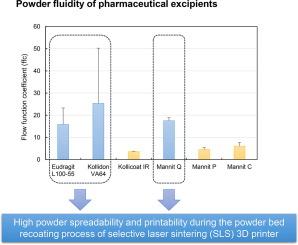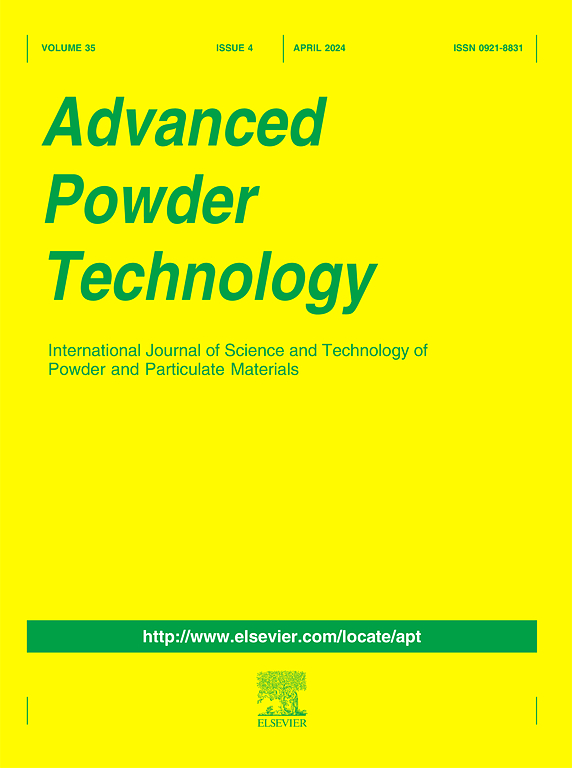辅料特性对通过选择性激光烧结三维打印技术制造药用打印件的影响
IF 4.2
2区 工程技术
Q2 ENGINEERING, CHEMICAL
引用次数: 0
摘要
本研究调查了辅料对使用选择性激光烧结(SLS)三维打印技术制造的打印件质量的影响。辅料采用了各种常用的热塑性聚合物和不同颗粒特性等级的甘露醇。SLS 可以生成复杂的结构并定制药物释放率,因此可用于个性化医疗。研究人员评估了选择合适辅料的意义,重点关注其粉末流动性和可印刷性,以及它们对印模特性的影响。确定了形成打印小片所需的激光吸收剂--黄色氧化铁的最佳用量。结果表明,具有最佳流动性和形状特征的辅料可大大提高打印小片的质量。使用粉末剪切池测试评估了辅料粉末特性(内摩擦角、剪切粘附力和流动功能系数)与 SLS 印刷结果之间的关系。粉末特性在很大程度上影响了使用撒粉器将粉末层从粉末储存器撒到构建平台上。此外,电子激光密度也会影响打印件的硬度。与传统片剂相比,制成的打印片具有更高的孔隙率和更快的溶解速度,这表明在药物生产中使用 SLS 具有潜在的优势。本文章由计算机程序翻译,如有差异,请以英文原文为准。

Effects of excipient properties on pharmaceutical printlet fabrication via selective laser sintering 3D printing
In this study, the impact of excipients on the quality of printlets manufactured using selective laser sintering (SLS) 3D printing was investigated. Various thermoplastic polymers, commonly used as pharmaceutical additives, and mannitol of different particle property grades, were used as excipients. SLS can produce complex structures and customize drug release rates; therefore, it can be used for personalized medicine. The significance of selecting suitable excipients, focusing on their powder flowability and printability, and their influence on the printlet properties was evaluated. An optimal amount of yellow iron oxide, a necessary laser-absorbing agent for printlet formation, was determined. Results revealed that excipients with optimal flow and shape characteristics considerably enhanced the printlet quality. The relation between the powder properties of excipients (internal friction angle, shear adhesion force, and flow function coefficient) and the SLS printing outcomes was evaluated using the powder shear cell test. The powder properties considerably affected the application of the powder layer using a spreader from the powder reservoir to the building platform. Moreover, the electron laser density impacted the printlet hardness. The as-fabricated printlets exhibited higher porosity and faster dissolution rates than traditional tablets, suggesting the potential advantages of using SLS in drug manufacturing.
求助全文
通过发布文献求助,成功后即可免费获取论文全文。
去求助
来源期刊

Advanced Powder Technology
工程技术-工程:化工
CiteScore
9.50
自引率
7.70%
发文量
424
审稿时长
55 days
期刊介绍:
The aim of Advanced Powder Technology is to meet the demand for an international journal that integrates all aspects of science and technology research on powder and particulate materials. The journal fulfills this purpose by publishing original research papers, rapid communications, reviews, and translated articles by prominent researchers worldwide.
The editorial work of Advanced Powder Technology, which was founded as the International Journal of the Society of Powder Technology, Japan, is now shared by distinguished board members, who operate in a unique framework designed to respond to the increasing global demand for articles on not only powder and particles, but also on various materials produced from them.
Advanced Powder Technology covers various areas, but a discussion of powder and particles is required in articles. Topics include: Production of powder and particulate materials in gases and liquids(nanoparticles, fine ceramics, pharmaceuticals, novel functional materials, etc.); Aerosol and colloidal processing; Powder and particle characterization; Dynamics and phenomena; Calculation and simulation (CFD, DEM, Monte Carlo method, population balance, etc.); Measurement and control of powder processes; Particle modification; Comminution; Powder handling and operations (storage, transport, granulation, separation, fluidization, etc.)
 求助内容:
求助内容: 应助结果提醒方式:
应助结果提醒方式:


